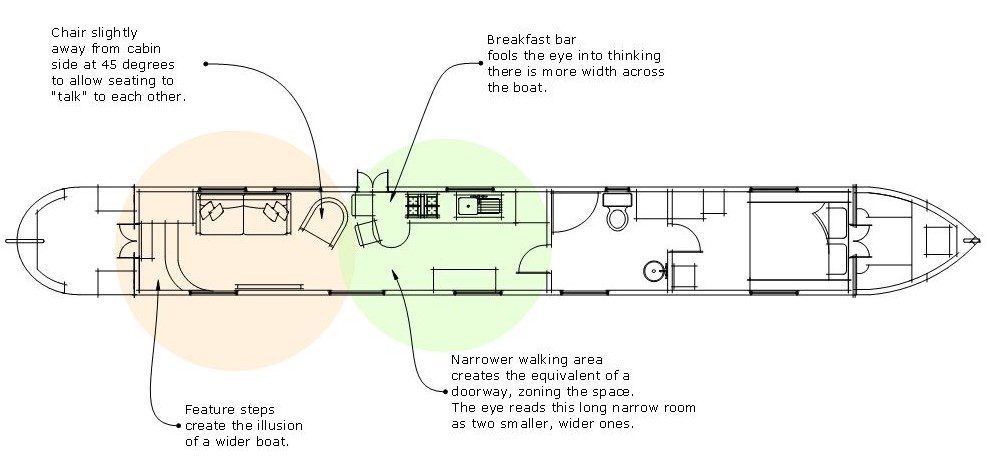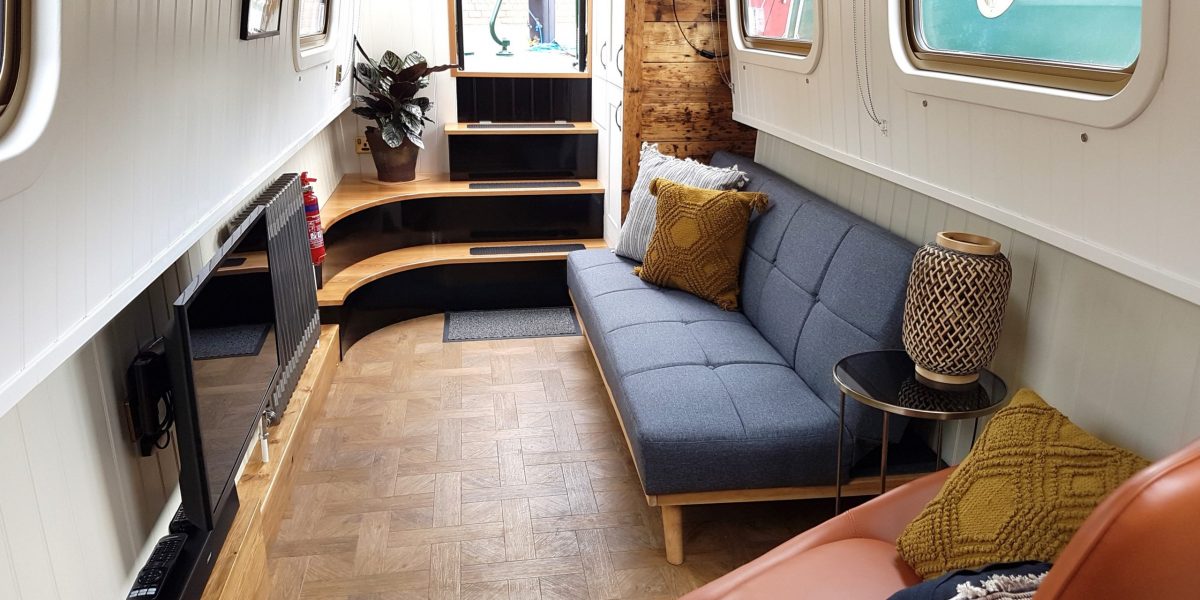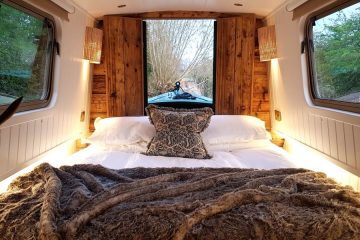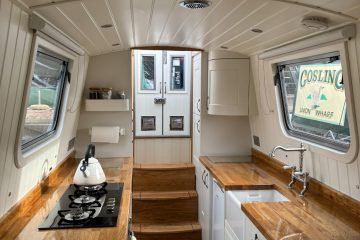Narrowboat saloon seating can be tricky. Folk see the kinds of sofas we use on our holiday boats and wonder if they can replicate the look on their own boat. But the solution to a common narrowboat problem (space vs comfort vs appearance) is not straightforward.
As an interior designer of narrowboats I’m always very conscious of the fact that people need to be comfortable sitting in a room just 6’10” wide. Often the client will request additional storage under the seating and there is almost always a television nearby, sometimes very close the viewer’s face. All this presents a tough challenge, both visually and in terms of how the space will work.
The visual challenge – and the solution
If you picture a typical land-based living room, you will imagine a sofa and/or chairs which are arranged so that they can “talk” to one another. Visually, this is a very appealing arrangement. It looks inviting and actually gives an illusion of space, as there is depth to the set up.
But on a narrowboat, this arrangement is very difficult to achieve without blocking a through route. As narrowboat designers, we have to use other visual tricks to fool the eye into thinking it is looking at a seating arrangement which has depth.
The easiest way to do this is to zone the space into shorter chunks, so that instead of a really long, straight room, you have two or three shorter ones which are of a more conventional proportion.
Zoning the interior doesn’t mean installing unnecessary bulkheads. It means introducing more visual lines across the width of the boat. A breakfast bar, for instance, will create the appearance of a wider boat. An L shaped kitchen layout will do the same. You can even create width by extending the steps so that they are longer than they need to be. If you then place a chair or small table at a 45 degree angle to a sofa, slightly away from the cabin side, you will create the illusion of a more natural furniture arrangement.
The drawing below shows how I have done this with the design of our hire boat, Marbled White.

Comfort in a narrowboat saloon seating area
Comfort is crucial, but there are many ways to consider this.
People sit in rows side by side if they are in a waiting room or at the theatre but otherwise we usually choose to sit at an angle from each other. In narrowboat design, this could mean using individual chairs if there is space, but that can be impractical if more than two people want to share the saloon. Bespoke dinette seating can be created in an L shape which can feel more natural than facing each other or sitting side by side, but of course many people prefer to relax in a less formal setting.
Which sofa?
Standard domestic sofas – whilst generally comfortable – are not very practical on narrowboats because they are simply the wrong size. They may not fit through the door and the angle of a the narrowboat sides means that often they sit further forward than expected. My rule of thumb is that a sofa should extend forward of the mid line or it will feel too bulky and awkward. I would also argue that a traditional sofa is impractical because it usually has arms. When paying to have a boat built, you can pay thousands for one or two extra feet of steelwork length which will be taken up by nothing but sofa arms.
One simple solution is to seek out the most comfortable Clic Clac sofa bed possible. These tend to be shallow and rarely cross the midline. They can also be armless and so very efficient, length-wise. Comfort can always be corrected with seat padding, sheepskins and plenty of cushions. Their modest dimensions more than make up for any negative points.

Bergere- style seating can be very successful. They are cane-backed with large cushions, so tend to be shallow. They have elegant wooden legs and can add a good dose of character. Seek out the genuine antiques to bring additional charm. Another good option is to hunt out a mid-century modern style of sofa, as these also often have slim wooden arms and a shallow seat, when compared with traditional sofas.
Saloon storage
Unless you are opting for a built-in dinette, I would urge you to consider sofas or chairs which have NO built in storage.
And yes, this advice goes against everything you’ve ever read about canal boat interiors to cram in as much storage as you can into all possible voids.
Instead, I recommend choosing narrowboat saloon seating which is freestanding and has proper legs. The reason for this is to do with the amount of floor that is visible. The human eye perceives increased depth and space with the greater amount of visible floor. So the more you can see under things, the bigger the space will appear to be. To create storage, I would then use baskets pushed right underneath the sofa, out of sight.
Compromise
Narrowboat interior design is full of compromises and tensions and the saloon seating area is no exception. But isn’t this why we love it? Where would be the challenge in furnishing a well-proportioned living space? With a few trade secrets, it is entirely possible to create a visually-pleasing design in a narrowboat.
Our aim at Boutique Narrowboats is to create beautiful interiors that work for narrow spaces and are practical for the extreme environmental conditions of narrowboats. We now have many tricks and techniques to create visually-appealing rooms and are often asked for our design expertise either informally or on a consultancy basis. We happily share our experience in this journal for narrowboat interiors.


